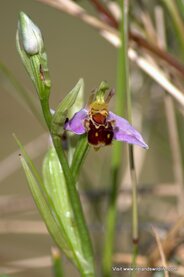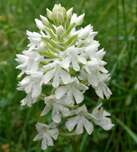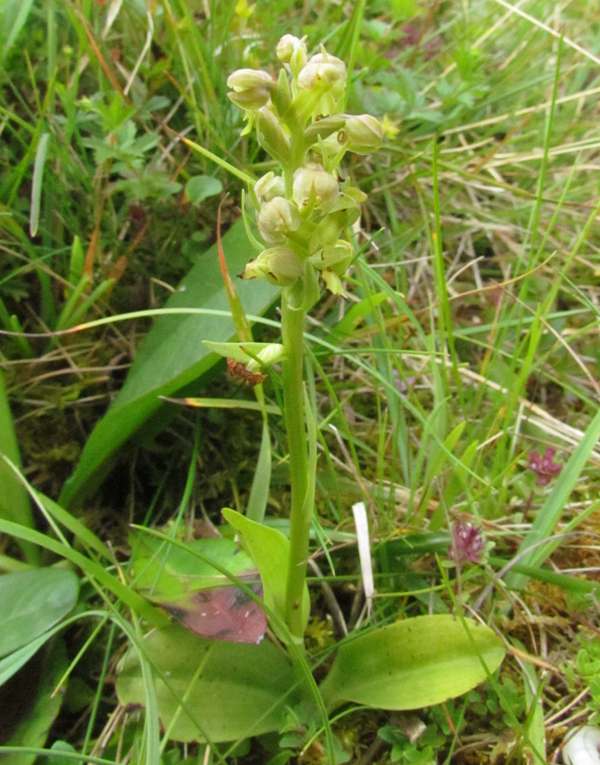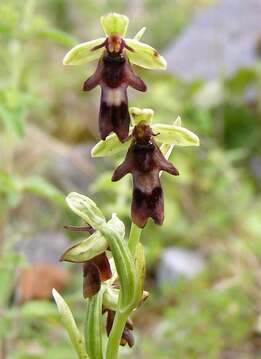|
An orchid’s blooming cycle can vary widely based on light, temperature, feeding and time of year. Although most orchids bloom just once a year, there are plenty of orchid varieties that can bloom twice a year and sometimes year-round. If you are an impatient gardener seeking prolific bloomers, here are a few varieties that you may want to try.  Guaritonia 'Why Not' Guaritonia 'Why Not' Guaritonia 'Why Not' This orchid boasts dark red blossoms with a bright yellow center. Flowers are approximately 1.5” across and bloom in clusters with anywhere between three to 12 flowers per cluster. A mature plant will bloom several times a year with it’s primary blooming cycle in the spring. They prefer warm temperatures, high moisture, well-drained potting media, bright light (but not direct light) and regular feeding. They do well in pots, baskets or attached to wood.  Cattlianthe 'Busy Bev' Cattlianthe 'Busy Bev' Cattlianthe 'Busy Bev' This regal looking hybrid boasts large flowers that are four to five inches in size. The blooms feature an intense purple lip and the outer petals are lavender to even a light bluish hue. This plant provides an extra bonus with a sweet fragrance that can attract butterflies. We recommend growing this plant like a typical Cattleya with high humidity, a well drained potting media and bright indirect light. The Blue Jewel typically blooms in the spring time, but with the right conditions it will bloom again later in the year.  Rhycattleanthe 'Burana Beauty' Rhycattleanthe 'Burana Beauty' Rhycattleanthe Burana Beauty The Cattleya hybrid, Burana Beauty, looks like happiness tie-dyed onto a flower. The blooms feature distinctive red stripes on the ruffled center two petals and lip which is contrasted against bright, sunny yellow outer petals. Burana Beauty will put out sprays with four to five blossoms per bunch and will bloom two to three times per year. This orchid grows well indoors with bright light in addition to outdoors in tropical zones. The Burana Beauty prefers a fir bark potting mixture. As if you needed one more reason to add this plant to your collection, the Burana Beauty features a delightful citrus scent.  Brassocattleya Yellow Bird A hearty plant due to its Brassavola parent cross, this orchid is great for beginners. The long, skinny leaves resemble conifer needles and are a nice balance to the delicate yellow flowers that resemble a star with a big, pouty, freckled lip. Flowers will last a few weeks at a time and open as a light pink and darken to a bright yellow within days. They grow well in baskets, pots and mounted to wood. Under the right conditions, a Yellow Bird can bloom throughout the year, and it emits a sweet scent. Special thanks to L. Krutz for sharing this photo of her Yellow Bird. Keep an eye out for these beauties at your local garden center.
Happy (Year-Round) Blooming from Better-Gro! The Oncidium genus includes roughly 330 species, but it’s often used in a less-technical term to refer to any number of 100,000-plus varieties and hybrids. The unifying trait of all of these orchids, regardless of how the term is used, is their swelling lower lip.  Onc. Sweet Sugar 'Lemon Drop' HCC/AOS Onc. Sweet Sugar 'Lemon Drop' HCC/AOS What Are Oncidium Orchids? In April 2013, researchers and orchid experts finally agreed to amend the Oncidium genus, which had come to be a “dumping ground” for orchids that didn’t fit in other genera. Most notably, equitant Oncidiums were reclassified into the Tolumnia genus. Other orchids that were reclassified included the mule-ear orchid, which was moved to the genus Trichocentrum, and the Brazilian oncidium, which is now part of the Gomesa genus. These changes show that even expert growers and researchers are still learning about the plants they love. While most official literature (such as American Orchid Society publications) has been updated to reflect these changes, Oncidium is still used by many to refer to plants that are technically part of other genera. After all, these orchids still all have a swollen lower lip. Thus, the term may be used to refer to about 330 species or to 100,000-plus hybrids. (Below, equitant Oncidiums will be compared to other types of orchids in the genera even though they’re now part of another genus.) Where Do Oncidiums Grow? Oncidium orchids are frequently found in Mexico and the Caribbean, although their natural habitat ranges from the southern portions of Florida through much of South America. They grow at all elevations in this large region, from sea level to the tree line of the Andes. Most Oncidiums are epiphytes and grow on trees. A few species are lithophytes (growing on rocks) or terrestrials (growing on the ground). 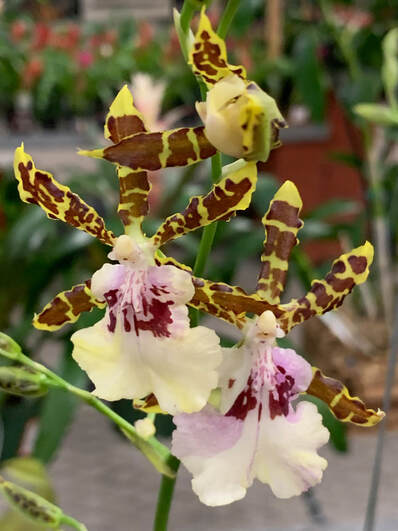 Onc. Wild Willie 'Pacific Bingo' Onc. Wild Willie 'Pacific Bingo' What Do Oncidium Orchids Look Like? Oncidiums are named for their flowers’ swollen lower lips. Oncidium comes from the Greek word “onkos,” which means “swelling.” The flowers are dominated by their lower lips, which are large, and often have ornate calluses or crests. Beyond this first common trait that defines all Oncidiums, these orchids can be further segregated into three categories based on appearance.
How Are Oncidiums Cared For?
Oncidiums don’t have many unique needs. Follow these general orchid care tips, and your Oncidium orchid should grow to be healthy and have great blooms. So you’ve had good luck with Moth Orchids (Phalaenopsis), and you’ve added color to your collection with a few showy Cattleyas. Now you may be looking to expand your collection but are worried that other varieties may be too difficult to grow. After all, most stores primarily sell Dendrobiums, Phalaenopsis and Cattleyas, so they must be the only easy orchids to grow, right? Wrong. The orchid family includes nearly 900 genera, and among those hundreds, there are lots of plants that are quite simple to grow under the same conditions as the most commonly available orchids. Let’s take a look at some additional varieties to add to your collection.  Brassavola Nodosa Commonly Known as "Lady of the Night" Not only is the white flower on this orchid quite unique, this hardy plant features a distinctive gardenia-like fragrance that peaks at night fall. Another reason we like this orchid is that when grown under the right conditions, Brassavola nodosa will bloom multiple times throughout the year. Temperature: Grows best in warmer temperatures ranging from 70º to 85º F and likes a slight drop in evening temps. Light: Prefers medium to high filtered light, similar to a Cattleya. Watering: Likes a well-drained potting media, such as Better-Gro ® Special Orchid Mix, or even a cork/driftwood mount so that the roots can air out between waterings. The Brassavola prefers a humid environment, so if you happen to live in a temperate zone, this plant will thrive outdoors. Feeding: Because this orchid will bloom throughout the year, it is recommended that you feed by alternating between our Better-Gro ® Orchid Plus ® and Better-Gro ® Better-Bloom ® plant foods using the recommendations on the label.  Oncidium 'Sweet Sugar' This orchid has been nicknamed the "Dancing Lady" due to its striking resemblance to a full-skirted silhouette that closely mimics a dancing lady when the flowers flutter in a gentle breeze. Some even say the flowers look like angels. Although the blossoms are typically just 1" or less in size, don’t be fooled by the tiny size of this plant’s flora. The sprays on this plant easily rival other larger-sized orchid blooms. Temperature: Thrives in day time temperatures ranging from 70º to 85º F. Light: Grows best with bright filtered light. Watering: Oncidiums are equipped to store water in their pseudobulbs which makes them more draught tolerant. Be sure to use a well-drained potting media, such as Better-Gro ® Special Orchid Mix, to allow the plant to dry between waterings and watch for the tell-tale sign that your orchid needs water when you see the pseudobulb start to shrivel. Feeding: We recommend the same plant food routine as listed above for both Oncidiums and Brassavola. Alternate between our Better-Gro ® Orchid Plus ®and Better-Gro ® Better-Bloom ® plant foods using the amounts shown on the label. In addition to this bright yellow color, Oncidiums are available in a variety of colors including red, pink, green, white and brown. Some varieties even have a scent including the 'Sharry Baby' variety that smells like chocolate.  Paphiopedilum Maudiae Makuli-Curtisii-Maudiae x Paph. Maudiae 'Napa Valley' HCC/AOS x Sib Don’t be fooled by this exotic looking orchid. Paphiopedilum maudiaes are one of the easiest orchid varieties to grow. Commonly referred to as the "Lady Slipper Orchid" because of the pouch-like lip that resembles the toe of a slipper, flowers on this plant will last up to two months and often bloom one to two times a year. The mottled foliage of the Paphiopedilum maudiae is prettier than most orchid varieties and rivals many indoor houseplants. Temperature: This orchid prefers cooler temperatures than the orchids listed above. The Paphiopedilum maudiae grows best between 65º to 85º F and needs cooler night temperatures to form buds. Light: In a natural setting, this orchid grows on the forest floor. In a greenhouse or outdoor environment, provide filtered light and avoid direct sunlight. Watering: Although the lip of this orchid looks like the ideal vessel to hold water, you should avoid getting water in the pouch as this will cause the flower to rot. Paphiopedilums don't have pseudobulbs like other orchid varieties, so it is important to water regularly. Potting media should remain cool to the touch, but water should flow completely through the pot to avoid root rot. Feeding: Paphiopedilums do not need as much plant food as other orchid varieties. We recommend cutting the strength of your plant food to a quarter or half strength of what is shown on the label. In addition to the white and light green flower shown above, the Paphiopedilum maudiae is also available in a deep eggplant purple. We hope you enjoy experimenting with these additional orchid varieties. They are sure to bring fresh blooms, interesting foliage and diversity to your collection.
Happy Blooming from Better-Gro!  It's likely that you have stopped to admire a Vanda at your local garden center or even seen them growing in a greenhouse or your neighborhood. These eye-catching orchids certainly attract attention. Less common than Phalaenopsis and Cattleya orchids, Vandas require slightly different care than other orchid varieties, but they are well worth the effort!  Blossoms Vandas are showy, long-lasting, frequent bloomers. They are very rewarding to grow and often times fragrant. Prized for their intense colors, they are commonly available in hot pink, orange, red and purple. The Vanda genus also includes a species with vibrant blue flowers called Vanda coerulea or the Blue Orchid (shown right). Unlike many other orchids that bloom just once a year, healthy Vandas can bloom throughout the year.  Leaves and Types Vandas are different from Cattleyas and Oncidiums in that they don’t have pseudobulbs. Water is retained in the plants' leaves which is why they need to be watered more frequently. Vandas come in three types and are easily distinguishable by looking at the plant's leaves.
 Vanda Origins Their natural habitat ranges from India and the Himalayas to China, the Philippines and New Guinea. A few species are found in the Western Pacific Islands and Queensland, Australia. Most species in the Vanda genus are epiphytes, meaning they grow on other plants without harming the host plant. By clinging to trees, Vandas have access to more sunlight versus growing on the forest floor, while still being shielded from direct sunlight by the tree canopy. In addition to growing in trees, some Vandas are lithophytic which means the grow on rocks, and some are terrestrial (grow on the ground). 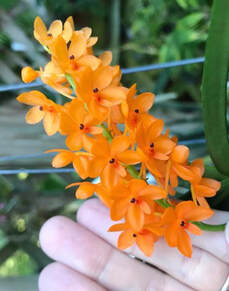 Plant Size Vandas come in many sizes. Some are tiny and can fit in the palm of your hand whereas others can grow up to 6 feet tall. Individual flowers range in size from less than an inch to four inches. They grow in clusters with up to 15 flowers per stem. Vandas are easily recognizable from other orchids due to their long, rambling roots that enable the plant to cling to trees. Often times, you will find Vanda roots growing two to four feet below the plant. Vandas are unique in that they do not grow in traditional orchid plant media like fir bark and charcoal.  Caring for Vandas If you are interested in learning more about the ideal conditions for growing Vandas, please visit our Vanda Care Instructions on the Better-Gro website. There you will find recommendations for temperature, light, watering, feeding and humidity. We hope you will consider bringing home your own Vanda in the future. Please send us your photos on Facebook, Instagram and Twitter with the hashtag #BetterGroBlooms. Happy Blooming from Better-Gro!
When you think of orchids, you typically think of tropical rain forests rather than the fields and mountains of Ireland. But , did you know Ireland is home to approximately 30 native species of orchids? In comparison to many epiphytic orchids that grow in the treetops, all of Ireland’s native orchids are terrestrial, growing in fields, bogs and limestone crevices. In honor of St. Patrick’s Day, we thought you might enjoy learning about some lesser-known orchids from the green island.
 Western Marsh Orchid The Western Marsh Orchid (Dactylorhiza occidentalis), commonly found in the Burren region of Ireland, also grows in other European countries such as Switzerland and Germany. This gorgeous orchid boasts dark spotted leaves with dense flower spikes ranging in length from 1.5” to 6”. Seven to 40 red-purple and pinkish-purple blossoms cover each spike. The Western Marsh Orchid makes for quite the site along roadsides, grasslands and marshes. May the luck of the Irish be with you and your orchids.
Happy Blooming with Better-Gro.
 Mini Care These plants have the same needs as their larger counterparts: humidity, light, and warm temperatures. Water: Because of the smaller pot size, often times they will require less water than a traditional phal. We suggest that you water once weekly, making sure the pot drains entirely through the drainage holes. If you keep the plant indoors, you may need to lightly mist your mini to add humidity. Or, you can place the orchid pot in a container of water and pebbles making sure the pot is sitting on top of the rocks and not directly in the water. Temperature: Your orchid will enjoy the same temperatures that you do in your home. Keep your plant in a location that ranges between 65 and 80° F. Light: Place your mini in a bright location but avoid direct sunlight which may burn the leaves. Typically, southern or eastern facing windows are best. Plant Food: Use a water soluble, balanced plant food designed for orchids. Follow the care instructions on the label. Big Bonus Like their larger-sized cousins, mini phals will often bloom two to three times a year. We hope you enjoyed this mini tutorial. 😍 Happy Blooming from Better-Gro We recently polled our Facebook fans and asked the question, “What's easier to grow - a Phalaenopsis or a Cattleya?” To our surprise, the results were almost a tie. 46% of our fans voted for the long-lasting moth orchid (Phalaenopsis) while 54% voted for the showy Cattleya. As with any plant, growing success depends on just the right amount of water, adequate lighting, the correct potting mix and access to nutrients. So, we thought we’d explore what it takes to grow both plants. Our beginners can give both plants a try, and our experienced orchid collectors may make a few changes to their collection.  Caring for a Phalaenopsis Light: Phalaenopsis plants prefer indirect sunlight and will also respond well to fluorescent grow lights. An Eastern-facing window is ideal or if you plan to put your orchid outdoors be sure it is filtered light. Direct sunlight can scorch the leaves leaving large round unsightly burns. Water: The Phalaenopsis is not equipped to store water like other orchid varieties which is why it is important to water your plants weekly. Water should run through the pot so that the orchid medium can soak up and retain that moisture. If you are using a plant liner or plant saucer, be sure to drain all the water so that your orchid is not sitting in water which can lead to root rot. Temperature: During the spring and summer months, Phalaenopsis plants prefer warm temperatures in the 75-85 F degree range. However, if you are keeping your Phalaenopsis plants indoors, they will adapt to cooler temperatures. To bloom each spring, Phalaenopsis plants prefer a drop in temperature to spur flower spikes. Potting Medium: Phalaenopsis plants can be grown in various types of orchid media. They do well with mixtures of bark, perlite and charcoal. This medium will retain just the right amount of moisture needed.  Cattleya Care Light: Just like the Phalaenopsis, the Cattleya can be grown indoors with artificial lighting or with indirect sunlight from an Eastern-facing window or filtered Southern exposure window. Water: The Cattleya is able to store water in its pseudobulbs therefore it can go for a longer period of time without water by using its natural water storage. However, it is best to water your plant weekly and be sure the water has completely drained from the pot. Temperatures: Most cattleyas prefer temperatures in the 70-80 F degree range, but in the summer time they can tolerate temperatures into the 90s as long as the plant receives sufficient water and air flow. During the winter, they can handle dips into the 50s. Potting Medium: Cattleyas will grow will in a variety of different media including tree bark, coconut husks, sphagnum moss and even lava rock. When selecting the medium for your plants consider your local humidity and watering routine. |
Resources
|
Company |
|

